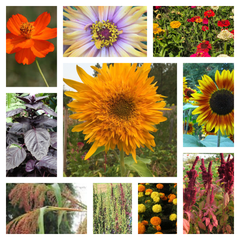Three Sisters Patch Seed Bundle
This is a collection of 8 packets: 1 Sweet corn, 2 flour corn, 2 pole beans, 2 winter squash,and 1 flower that is the perfect starting point to growing your own 3 Sisters staple crop garden.
8 packets (our choice of the mix): ($6.50 savings)
See Below for more background information:
Three Sisters Companion Planting
The three Sisters approach to growing corn, beans, and squash together as a polyculture developed in the arid Southwestern USA. In the sandy soils there, the early indigenous farmers would poke a hole with a planting stick 8-12” deep and pour the seeds of corn, pole beans and winter squash all into the same hole to encourage them to root where there was residual moisture. The corn, being a monocot would push up first and the beans and squash later, ensuring that they wouldn’t topple the corn.
The Corn in clumps spaced 6-8 feet apart while the beans climbed its stalks and the squash trailed along the ground providing a living mulch.
For most of us, if we were to plant these seeds a foot deep, the seeds would all rot, so we must adapt this strategy to our garden conditions. I suggest planting the corn 4-8 seeds in hills spaced 4-6 feet apart. Once it is 4” tall plant pole beans & winter squash next to the corn plants. This gives the corn a head start so it isn’t strangled by vining bean plants. The pole beans weave the corn stalks together, which helps to avoid the stalks from falling over (lodging). Three sisters is done with dry corn (flourtype), dry beans(shelling), and winter squash
because the planting develops into such a jungle if done well, that you would not want to be traipsing through there to check if your sweet corn, snap peas or summer squash was ready. Rather you simply allow it to flourish over the summer and harvest it all in the fall when mature.
Many blessings on your gardening endeavors!
CORN - Zea mays
Growing Tips: Plant corn by direct seeding 1-2” deep after soil has warmed to at least 70° (Triple Play, Painted Hills Sweet & Hooker’s are specifically adapted to cool soil planting so can be planted earlier in the season). You can also transplant corn for earlier crops, but you have to baby them a bit.
Plant Spacing: Seed 6-10 per foot and thin to 1 plant per 8-12”, rows should be 24-36” apart. Hill method: Plant 5-10 seeds 1-2” deep in a mound, which should be 4-5 feet apart. Grow squash in-between and plant pole beans in mound once corn has emerged. Works better with flour corn and popcorn as it becomes somewhat jungle-like to harvest sweet corn with this method.
Pests: Protect young seedlings from bird predation with floating row covers. A common novice gardener problem is to assume that their corn didn’t come up; when in actuality birds such as jays, robins and crows were digging and pulling up the young sprouts. Scarecrows, floating eye balloons and reflective tape are somewhat effective. Dogs are good, too. Corn earworms (which are actually the caterpillar stage of a moth) can be controlled by spraying Bt. (Dipel™ is a brand name of OMRI certified organic control). Or just bear with their minor inconvenience by chopping the tips off of infected ears.
Harvest: Sweet corn when it’s in the “milk” stage, which you can determine by finding an ear whose silks have dried, gently peeling back some leaves while the ear is still on the plant, then nicking a kernel and looking for milky liquid to ooze out. Clear fluid indicates that it is too early, no liquid – you’re too late, save for seed or flour corn. Raccoons can devastate a corn crop if they find it appealing. Some folks put a battery powered radio in their patch to provide a menacing noise deterrent to keep coons at bay.
Diseases: We have not experienced any significant diseases here in Oregon, but my counsel would be ample fertility from well-matured compost and foliar sprays of compost tea, fish emulsion and kelp when plants are young if you do experience yellowing or die back.
Seed Specs: Sweet: 125-225 seeds per/oz.; Popcorn: 250-300 seeds/oz.


